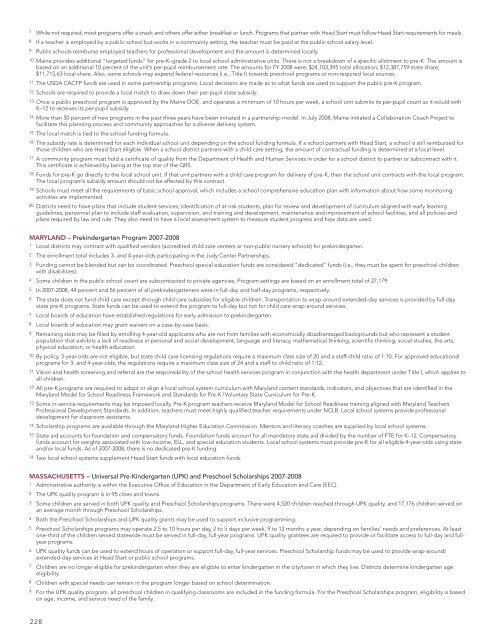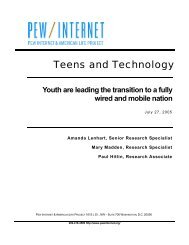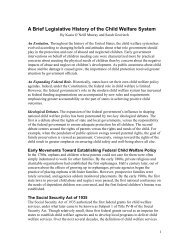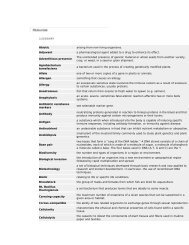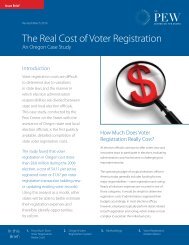Report: The State of Preschool 2008: State Preschool Yearbook
Report: The State of Preschool 2008: State Preschool Yearbook
Report: The State of Preschool 2008: State Preschool Yearbook
Create successful ePaper yourself
Turn your PDF publications into a flip-book with our unique Google optimized e-Paper software.
7 While not required, most programs <strong>of</strong>fer a snack and others <strong>of</strong>fer either breakfast or lunch. Programs that partner with Head Start must follow Head Start requirements for meals.<br />
8 If a teacher is employed by a public school but works in a community setting, the teacher must be paid at the public school salary level.<br />
9 Public schools reimburse employed teachers for pr<strong>of</strong>essional development and the amount is determined locally.<br />
10 Maine provides additional “targeted funds” for pre-K–grade 2 to local school administrative units. <strong>The</strong>re is not a breakdown <strong>of</strong> a specific allotment to pre-K. <strong>The</strong> amount is<br />
based on an additional 10 percent <strong>of</strong> the unit’s per-pupil reimbursement rate. <strong>The</strong> amounts for FY <strong>2008</strong> were: $24,103,395 total allocation; $12,387,759 state share;<br />
$11,715,63 local share. Also, some schools may expend federal resources (i.e., Title I) towards preschool programs or non-required local sources.<br />
11 <strong>The</strong> USDA CACFP funds are used in some partnership programs. Local decisions are made as to what funds are used to support the public pre-K program.<br />
12 Schools are required to provide a local match to draw down their per-pupil state subsidy.<br />
13 Once a public preschool program is approved by the Maine DOE, and operates a minimum <strong>of</strong> 10 hours per week, a school unit submits its per-pupil count as it would with<br />
K–12 to receives its per-pupil subsidy.<br />
14 More than 50 percent <strong>of</strong> new programs in the past three years have been initiated in a partnership model. In July <strong>2008</strong>, Maine initiated a Collaboration Coach Project to<br />
facilitate this planning process and community approaches for a diverse delivery system.<br />
15 <strong>The</strong> local match is tied to the school funding formula.<br />
16 <strong>The</strong> subsidy rate is determined for each individual school unit depending on the school funding formula. If a school partners with Head Start, a school is still reimbursed for<br />
those children who are Head Start eligible. When a school district partners with a child care setting, the amount <strong>of</strong> contractual funding is determined at a local level.<br />
17 A community program must hold a certificate <strong>of</strong> quality from the Department <strong>of</strong> Health and Human Services in order for a school district to partner or subcontract with it.<br />
This certificate is achieved by being at the top star <strong>of</strong> the QRS.<br />
18 Funds for pre-K go directly to the local school unit. If that unit partners with a child care program for delivery <strong>of</strong> pre-K, then the school unit contracts with the local program.<br />
<strong>The</strong> local program’s subsidy amount should not be affected by this contract.<br />
19 Schools must meet all the requirements <strong>of</strong> basic school approval, which includes a school comprehensive education plan with information about how some monitoring<br />
activities are implemented.<br />
20 Districts need to have plans that include student services, identification <strong>of</strong> at-risk students, plan for review and development <strong>of</strong> curriculum aligned with early learning<br />
guidelines, personnel plan to include staff evaluation, supervision, and training and development, maintenance and improvement <strong>of</strong> school facilities, and all policies and<br />
plans required by law and rule. <strong>The</strong>y also need to have a local assessment system to measure student progress and how data are used.<br />
MARYLAND – Prekindergarten Program 2007-<strong>2008</strong><br />
1 Local districts may contract with qualified vendors (accredited child care centers or non-public nursery schools) for prekindergarten.<br />
2 <strong>The</strong> enrollment total includes 3- and 4-year-olds participating in the Judy Center Partnerships.<br />
3 Funding cannot be blended but can be coordinated. <strong>Preschool</strong> special education funds are considered “dedicated” funds (i.e., they must be spent for preschool children<br />
with disabilities).<br />
4 Some children in the public school count are subcontracted to private agencies. Program settings are based on an enrollment total <strong>of</strong> 27,179.<br />
5 In 2007-<strong>2008</strong>, 44 percent and 56 percent <strong>of</strong> all prekindergarteners were in full-day and half-day programs, respectively.<br />
6 <strong>The</strong> state does not fund child care except through child care subsidies for eligible children. Transportation to wrap-around extended-day services is provided by full-day<br />
state pre-K programs. <strong>State</strong> funds can be used to extend the program to full-day but not for child care wrap-around services.<br />
7 Local boards <strong>of</strong> education have established regulations for early admission to prekindergarten.<br />
8 Local boards <strong>of</strong> education may grant waivers on a case-by-case basis.<br />
9 Remaining slots may be filled by enrolling 4-year-old applicants who are not from families with economically disadvantaged backgrounds but who represent a student<br />
population that exhibits a lack <strong>of</strong> readiness in personal and social development, language and literacy, mathematical thinking, scientific thinking, social studies, the arts,<br />
physical education, or health education.<br />
10 By policy, 3-year-olds are not eligible, but state child care licensing regulations require a maximum class size <strong>of</strong> 20 and a staff-child ratio <strong>of</strong> 1:10. For approved educational<br />
programs for 3- and 4-year-olds, the regulations require a maximum class size <strong>of</strong> 24 and a staff to child ratio <strong>of</strong> 1:12.<br />
11 Vision and health screening and referral are the responsibility <strong>of</strong> the school health services program in conjunction with the health department under Title I, which applies to<br />
all children.<br />
12 All pre-K programs are required to adopt or align a local school system curriculum with Maryland content standards, indicators, and objectives that are identified in the<br />
Maryland Model for School Readiness Framework and Standards for Pre-K /Voluntary <strong>State</strong> Curriculum for Pre-K.<br />
13 Some in-service requirements may be imposed locally. Pre-K program teachers receive Maryland Model for School Readiness training aligned with Maryland Teachers<br />
Pr<strong>of</strong>essional Development Standards. In addition, teachers must meet highly qualified teacher requirements under NCLB. Local school systems provide pr<strong>of</strong>essional<br />
development for classroom assistants.<br />
14 Scholarship programs are available through the Maryland Higher Education Commission. Mentors and literacy coaches are supplied by local school systems.<br />
15 <strong>State</strong> aid accounts for foundation and compensatory funds. Foundation funds account for all mandatory state aid divided by the number <strong>of</strong> FTE for K–12. Compensatory<br />
funds account for weights associated with low-income, ELL, and special education students. Local school systems must provide pre-K for all eligible 4-year-olds using state<br />
and/or local funds. As <strong>of</strong> 2007-<strong>2008</strong>, there is no dedicated pre-K funding.<br />
16 Two local school systems supplement Head Start funds with local education funds.<br />
MASSACHUSETTS – Universal Pre-Kindergarten (UPK) and <strong>Preschool</strong> Scholarships 2007-<strong>2008</strong><br />
1 Administrative authority is within the Executive Office <strong>of</strong> Education in the Department <strong>of</strong> Early Education and Care (EEC).<br />
2 <strong>The</strong> UPK quality program is in 95 cities and towns.<br />
3 Some children are served in both UPK quality and <strong>Preschool</strong> Scholarships programs. <strong>The</strong>re were 4,520 children reached through UPK quality, and 17,176 children served on<br />
an average month through <strong>Preschool</strong> Scholarships.<br />
4 Both the <strong>Preschool</strong> Scholarships and UPK quality grants may be used to support inclusive programming.<br />
5 <strong>Preschool</strong> Scholarships programs may operate 2.5 to 10 hours per day, 2 to 5 days per week, 9 to 12 months a year, depending on families’ needs and preferences. At least<br />
one-third <strong>of</strong> the children served statewide must be served in full-day, full-year programs. UPK quality grantees are required to provide or facilitate access to full-day and fullyear<br />
programs.<br />
6 UPK quality funds can be used to extend hours <strong>of</strong> operation or support full-day, full-year services. <strong>Preschool</strong> Scholarship funds may be used to provide wrap-around/<br />
extended-day services at Head Start or public school programs.<br />
7 Children are no longer eligible for prekindergarten when they are eligible to enter kindergarten in the city/town in which they live. Districts determine kindergarten age<br />
eligibility.<br />
8 Children with special needs can remain in the program longer based on school determination.<br />
9 For the UPK quality program, all preschool children in qualifying classrooms are included in the funding formula. For the <strong>Preschool</strong> Scholarships program, eligibility is based<br />
on age, income, and service need <strong>of</strong> the family.<br />
228


